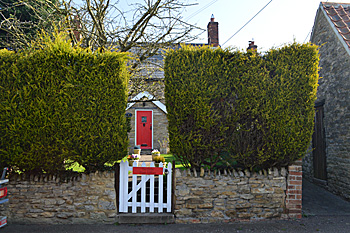Ye Olde Post Office Souldrop

Ye Olde Post Office April 2015
The former post office was listed by English Heritage in August 1987 as Grade II, of special interest. It dates from the late 18th century and is built of local limestone rubble, with a slate roof. It comprises two storeys and has a modern porch.
By 1922 the cottage formed part of the Colworth Estate, which was put up for sale by auction in that year. It seems likely that the building had always formed part of the Manor of Souldrop. The sale particulars [Z1246/1] describe it as Souldrop Post Office standing in eleven poles of land. “in occupation of Mr Hugh Phillips on a Monthly Tenancy. The following accommodation is afforded: Shop, Sitting Room, Kitchen, Pantry, dairy, two Bedrooms and Outbuildings”. The whole estate was withdrawn as not sold and offered again in 1924 [Z1323/1/4].
The Rating and Valuation Act 1925 specified that every building and piece of land in the country was to be assessed to determine its rateable value. The valuer visiting the property [DV1/C167/37] found that it was owned and occupied by Fanny Phillips, bought, no doubt, in 1924. The stone and tiled building was at the end of a row of three and was “almost detached”.
Accommodation comprised a living room and kitchen with two bedrooms above. The post office and shop measured 11 feet by 17 feet. There were also: an old barn used as a store; another barn and an earth closet. The valuer opined: “Stands back from road. Nice place”.
Directories for Bedfordshire were published every few years until 1940. The first one to mention a postmaster in Souldrop is 1885. In the past the post office was not always in the same place but tended to move when the job changed hands, so all the people on the following list may not necessarily have lived at Ye Olde Post Office:
- John Lake Willis: 1885, 1890, 1894;
- Edward Barnes: 1898 – he was also the village blacksmith;
- George Henry Brown: 1903;
- John Rowkins: 1906; 1910
- Mrs Fanny Phillips: 1914, 1920, 1924, 1928, 1931;
- Lewis Hinton: 1936, 1940.